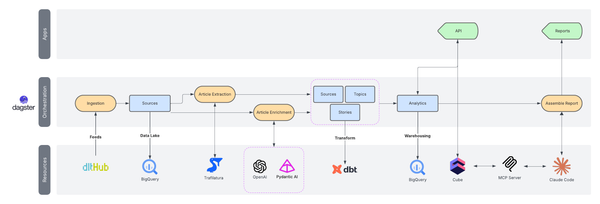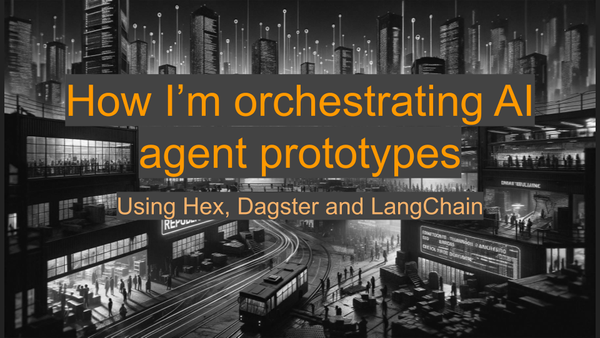Agentic Data Fusion for Market Intelligence
How we built a multi-agent intelligence pipeline that fuses internal data with external signals to uncover hidden market dynamics and generate strategic insights.
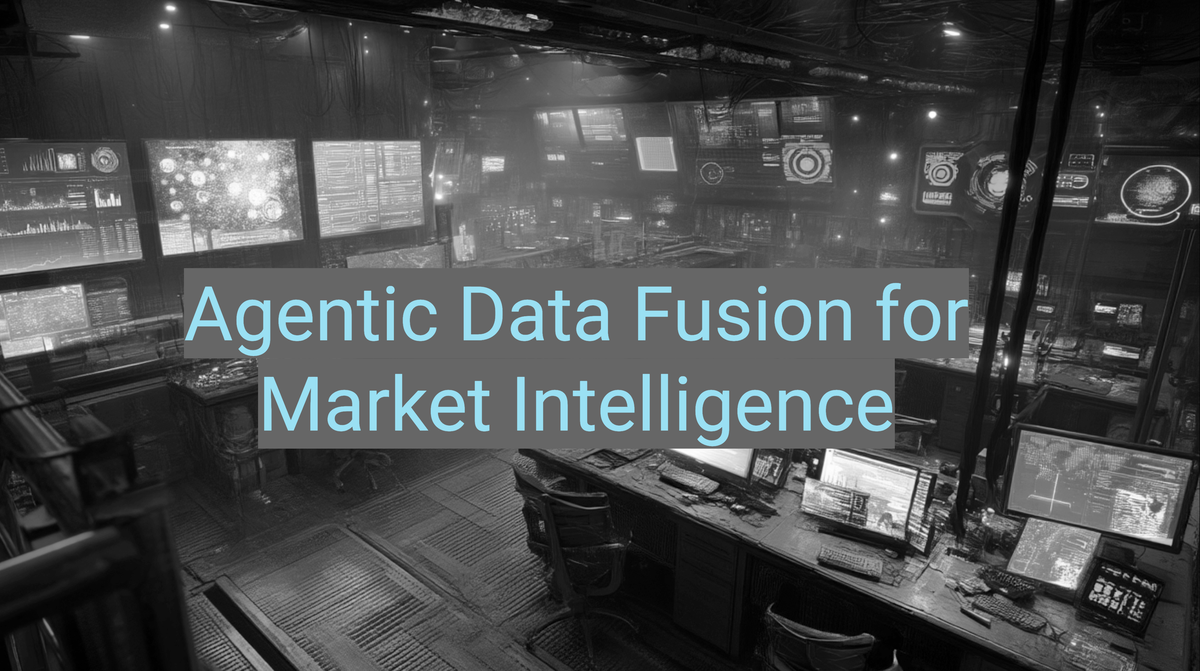
TL;DR — Static data tells you what. External intelligence tells you why. We built an agentic system that combines both to uncover hidden market dynamics and generate intelligence that neither source could provide alone.
The Hidden Intelligence Asset
Most organizations maintain rich proprietary datasets—customer records, transaction histories, market positions—but struggle to connect these with external market signals. The gap between what you know internally and what's happening externally creates strategic blind spots.
We demonstrated how to bridge this gap with ListEdTech's Pulse Pilot, transforming static institutional records into dynamic competitive intelligence.
Context: ListEdTech's Data Challenge
ListEdTech maintains the education technology sector's most comprehensive implementation database—5.2 million manually validated records covering both Higher Education and K-12 institutions. Their challenge: transform this static asset into real-time market intelligence without hiring an army of analysts.
The solution: A multi-agent AI pipeline that fuses internal data with external intelligence, creating insights neither source could provide alone.
Pilot Results
| Metric | Traditional Approach | AI Pipeline | Impact |
|---|---|---|---|
| Monthly Cost | $4,000 (0.5 FTE) | $400 | 90% reduction |
| Time to Insights | 2-4 weeks | 24-48 hours | 10x faster |
| Source Coverage | 20-30 manual | 100+ automated | 3x broader |
| Validation Work | 100% manual | 50% automated | Half the effort |
System Architecture: Five-Stage Intelligence Pipeline
The Pulse system implements a five-stage pipeline where specialized agents transform raw data into strategic intelligence:
Each stage serves a specific purpose in the intelligence generation process:
- Search Orchestration: Multi-source discovery using SerpAPI and Perplexity
- Source Enrichment: Content extraction and relevance scoring with Tavily
- Data Analysis: Internal chart insights generation
- Theme Synthesis: Data fusion combining internal + external intelligence
- Report Generation: Editorial assembly with evidence chains
The Data Fusion Intelligence Engine
Here's how the system creates exponential value by combining internal and external data:
Cayuse 24.9% market share
1247 of 5012 institutions] A2[External Signal
Loyola University implements
Cayuse Research Suite] end subgraph "Processing Engine" B1[Chart Insights Agent
Analyzes market position] B2[Source Evaluation Agent
Validates external announcement] B3[Theme Synthesis Agent
Combines internal + external] end subgraph "Intelligence Outputs" C1[Quantitative Finding
Cayuse holds dominant position
Confidence: 89%] C2[Market Signal
Continued customer acquisition
validates market strength] C3[Strategic Intelligence
Market leadership confirmed by
both data and customer adoption] end A1 --> B1 A2 --> B2 B1 --> C1 B2 --> C2 B1 --> B3 B2 --> B3 B3 --> C3
This example demonstrates how the system creates value by connecting quantitative market position data with qualitative market signals, generating strategic intelligence that requires both data types to produce.
Core Agent Pattern
Every agent follows a consistent architecture using GPT-4.1, LangChain, Pydantic, and LangSmith:
from langchain_openai import ChatOpenAI
from langchain_core.prompts import ChatPromptTemplate
from pydantic import BaseModel, Field
from typing import List, Literal
# 1. Define structured output schema with Pydantic
class ChartInsight(BaseModel):
chart_id: str
metric_name: str = Field(description="Primary metric being analyzed")
time_window: str = Field(description="ISO-8601 range or 'point-in-time'")
trend_type: Literal["rising", "declining", "stable", "seasonal"]
significance: float = Field(ge=0, le=1, description="Statistical significance")
narrative: str = Field(description="Plain-language insight summary")
confidence: float = Field(ge=0, le=1, description="Analysis confidence")
# 2. Initialize LLM with structured output
llm = ChatOpenAI(model="gpt-4.1", temperature=0.7)
# 3. Create prompt template
chart_analysis_prompt = ChatPromptTemplate.from_template("""
You are an expert data analyst examining market intelligence charts.
Analyze the provided chart data and generate actionable insights.
Chart Data: {chart_data}
Chart Type: {chart_type}
Business Context: {context}
Focus on:
- Statistical trends and patterns
- Market positioning implications
- Competitive dynamics revealed
- Strategic recommendations
Provide structured analysis with confidence scores.
""")
# 4. Build agent pipeline
chart_insights_agent = chart_analysis_prompt | llm.with_structured_output(
ChartInsight, method="function_calling"
)
# 5. Execute with monitoring (LangSmith traces automatically captured)
def analyze_chart(chart_data: dict, chart_type: str, context: str) -> ChartInsight:
return chart_insights_agent.invoke({
"chart_data": chart_data,
"chart_type": chart_type,
"context": context
})
Architecture Benefits:
- Structured I/O: Pydantic ensures consistent data flow between agents
- Type Safety: Full type checking and validation at runtime
- Observability: LangSmith provides complete execution traces
- Reproducibility: Deterministic outputs with controlled temperature
- Modularity: Each agent is self-contained and composable
Configuration-Driven Scaling Architecture
The Pulse engine was designed to adapt to different market verticals through configuration rather than custom development—demonstrating the potential for a multi-vertical intelligence platform.
The Reusable Engine Concept:
# Domain-agnostic topic configuration
CONTROLLED_TOPICS = {
"product_update": "New features, platform enhancements, version releases",
"acquisition_or_merger": "Company acquisitions, mergers, strategic partnerships",
"strategic_shift": "Changes in vendor focus, market positioning, business model",
"regulatory_compliance": "Compliance updates, regulatory changes, policy impacts",
"competitive_response": "Reactions to competitor moves, market repositioning"
# Add new categories without code changes
}
# Market vertical configurations
MARKET_CONFIGS = {
"grants_management": {
"category": "Grants Management Systems",
"key_players": ["Cayuse", "InfoEd", "Euna Solutions", "AmpliFund"],
"data_sources": ["university_websites", "press_releases", "product_updates"],
"search_contexts": ["research_administration", "grant_compliance", "funding_management"]
},
"learning_management": {
"category": "Learning Management Systems",
"key_players": ["Canvas", "Blackboard", "Moodle", "Brightspace"],
"data_sources": ["education_news", "implementation_announcements", "feature_releases"],
"search_contexts": ["online_learning", "educational_technology", "student_engagement"]
}
# Add new verticals through configuration
}
# Configuration-driven report generation
def generate_vertical_report(vertical_config: dict, timeframe: str) -> IntelligenceReport:
"""Same Pulse engine, different market focus through configuration"""
return pulse_intelligence_engine.generate_report(
vertical=vertical_config,
topics=CONTROLLED_TOPICS,
timeframe=timeframe
)
Let's dive into a few of the engine stages...
Search Orchestration
The search layer transforms business research topics into comprehensive web intelligence by orchestrating multiple search engines and optimizing queries for each platform.
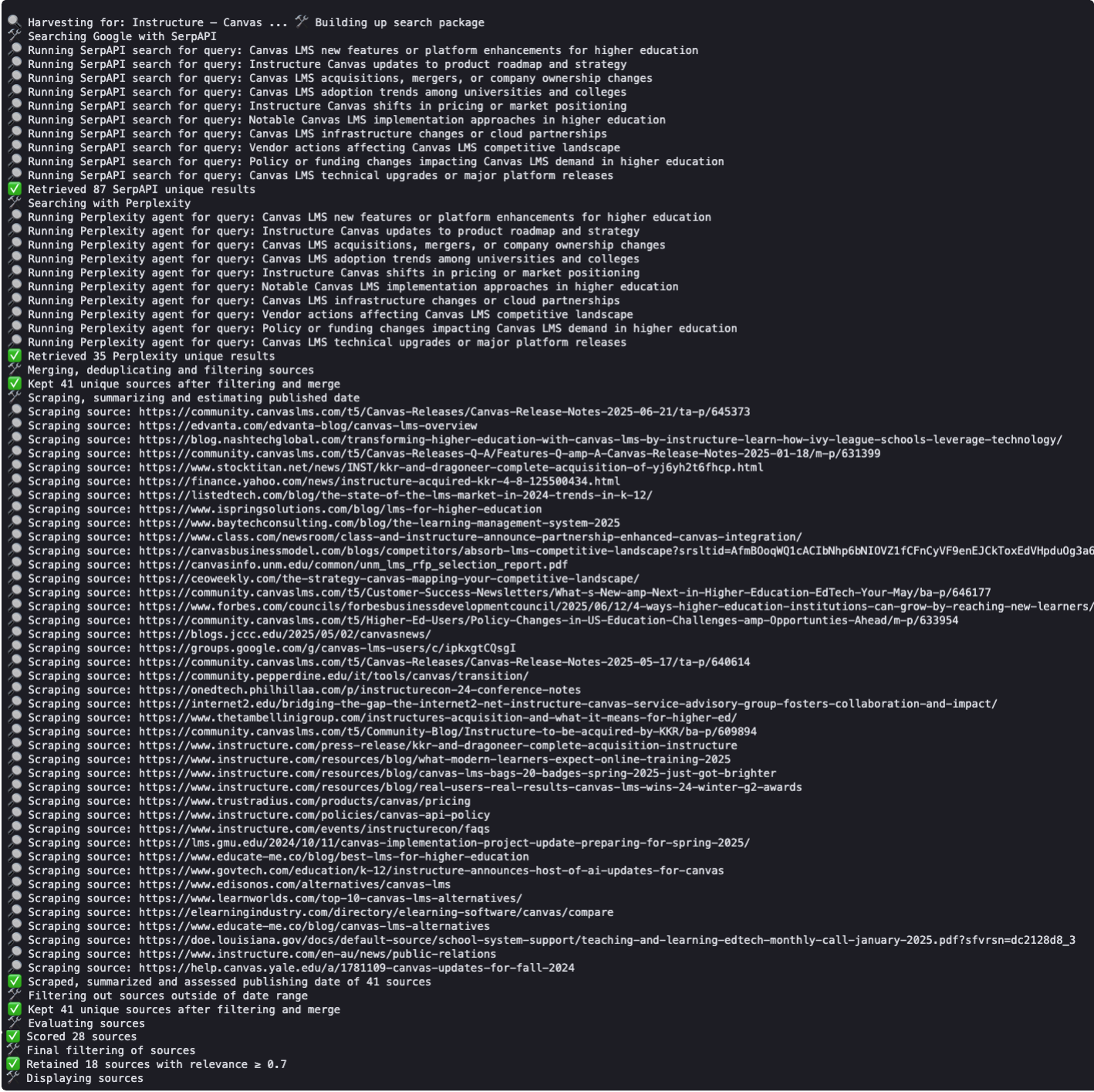
LLM-Powered Query Optimization
The system uses specialized prompts to transform business research topics into effective search queries:
# Production prompt for search optimization
current_market_insights_prompt = ChatPromptTemplate.from_template("""
You are a research assistant preparing optimized search strategies for market intelligence.
Research Topic: {topic}
Company Focus: {company}
Time Period: {start_date} to {end_date}
Generate up to 10 concise, natural-language search queries that will discover:
- Recent news and announcements
- Product updates and feature releases
- Strategic partnerships and acquisitions
- Market positioning and competitive moves
- Customer implementations and case studies
Avoid quoting phrases or using overly strict boolean syntax.
Focus on discovering authoritative sources and recent developments.
""")
Search Strategy Lessons from Implementation:
- Natural language beats boolean: LLM-enhanced engines respond better to conversational queries
- Multiple targeted queries outperform single complex queries: 8-10 focused searches vs. 1-2 comprehensive searches
- Date filtering handled separately: Search engines handle temporal filtering better than query-embedded dates
- Domain-specific keyword lists: Industry terminology improves precision and recall
Multi-Source Search
Those search queries are than ran against multiple systems:
class PulseSearchPromptPackage(BaseModel):
original_topic: str
search_queries: List[str] # Optimized queries for each engine
include_keywords: List[str]
exclude_keywords: List[str]
# Real implementation from production notebook:
def run_serpapi_search(prompt_package, start_date, end_date):
"""Google search with date filtering and result deduplication"""
# Implementation handles pagination, rate limiting, and URL deduplication
pass
def run_perplexity_agent(prompt_package, start_date, end_date):
"""AI-powered search with source validation and quality scoring"""
# Perplexity provides curated results with built-in fact-checking
pass
def run_tavily_extraction(urls_list):
"""Content extraction and summarization for discovered sources"""
# Tavily processes full web pages and extracts key information
pass
Key Technical Decisions:
- SerpAPI for comprehensive web coverage and historical search capabilities
- Perplexity for AI-enhanced source discovery and quality pre-filtering
- Tavily for content extraction, eliminating complex web scraping
- URL deduplication across all sources prevents redundant processing
Source Quality Pipeline
Every discovered source passes through automated evaluation and scoring:
class PulseEnrichedSource(BaseModel):
original_url: str
title: str
content_summary: str
relevance_score: float = Field(ge=0.0, le=1.0)
classification: str # product, strategy, regulatory, financial
source_analysis: str # LLM reasoning for inclusion/exclusion
low_confidence: bool = False
publication_date: str
# Evaluation agent with structured output
pulse_source_evaluator_agent = evaluation_prompt | llm.with_structured_output(
PulseEnrichedSource, method="function_calling"
)
Quality Control Features:
- Automated relevance scoring: 0.0 to 1.0 scale with confidence intervals
- Topical classification: Strategic categorization for downstream processing
- Low-confidence flagging: Sources requiring human review are marked
- Evaluation reasoning: LLM provides explanation for inclusion/exclusion decisions
Internal Data Analysis: Chart Insights Engine
The chart insights engine transforms static visualizations into structured intelligence by automatically analyzing proprietary data and generating strategic insights with confidence scores.

Chart Insight Generation Architecture
class ChartInsight(BaseModel):
chart_id: str
metric_name: str # e.g., 'market_share_pct', 'adoption_rate'
time_window: str # ISO-8601 range or 'point-in-time'
trend_type: Literal["rising", "declining", "stable", "seasonal"]
significance: float = Field(ge=0, le=1, description="Statistical significance")
narrative: str # Plain-language insight summary
confidence: float = Field(ge=0, le=1, description="Analysis confidence")
supporting_data: dict # Raw metrics that support the insight
# Production chart analysis agent
current_market_insights_agent = chart_analysis_prompt | llm.with_structured_output(
ChartInsights, method="function_calling"
)
Analysis Types Implemented:
- Current Market Share Analysis: Bar charts showing vendor positioning
- Historical Trend Analysis: Time series revealing market dynamics
- Competitive Positioning: Scatter plots mapping vendor relationships
- Implementation Momentum: Adoption data showing market velocity

Strategic Synthesis: Theme Curation Engine
The theme curation engine represents the core data fusion capability—where internal chart insights meet external intelligence to create strategic themes that neither source could provide alone.
Data Fusion Architecture
class Theme(BaseModel):
theme_id: str
name: str # Short, reader-friendly theme label
summary: str # Concise executive summary
description: str # Extended strategic explanation
implications: str # Business impact analysis
classification: str # product, strategy, regulatory, financial
chart_refs: List[str] # Supporting internal chart insights
story_refs: List[str] # Supporting external web sources
outlook: Literal["positive", "negative", "neutral", "uncertain"]
confidence: float = Field(ge=0, le=1)
evidence_strength: Literal["strong", "moderate", "weak"]
# Multi-modal synthesis agent combining internal + external data
theme_curator_agent = theme_synthesis_prompt | llm.with_structured_output(
ThemeBatch, method="function_calling"
)
The Data Fusion Process
Data Fusion Intelligence Flow:
- Internal Context: Chart insights provide quantitative foundation
- Market share percentages and competitive positioning
- Historical trends and momentum indicators
- Statistical significance and confidence scores
- External Intelligence: Web sources provide qualitative context
- Strategic announcements and product launches
- Partnership agreements and acquisition news
- Customer implementations and market signals
- Fusion Engine: Theme synthesis combines both data types
- Internal metrics explain what is happening quantitatively
- External sources explain why it's happening strategically
- Combined intelligence reveals where the market is heading
- Strategic Output: Contextualized themes with evidence chains
- Hard data becomes actionable intelligence
- Quantitative patterns gain strategic narrative
- Audit trails connect internal metrics to external validation
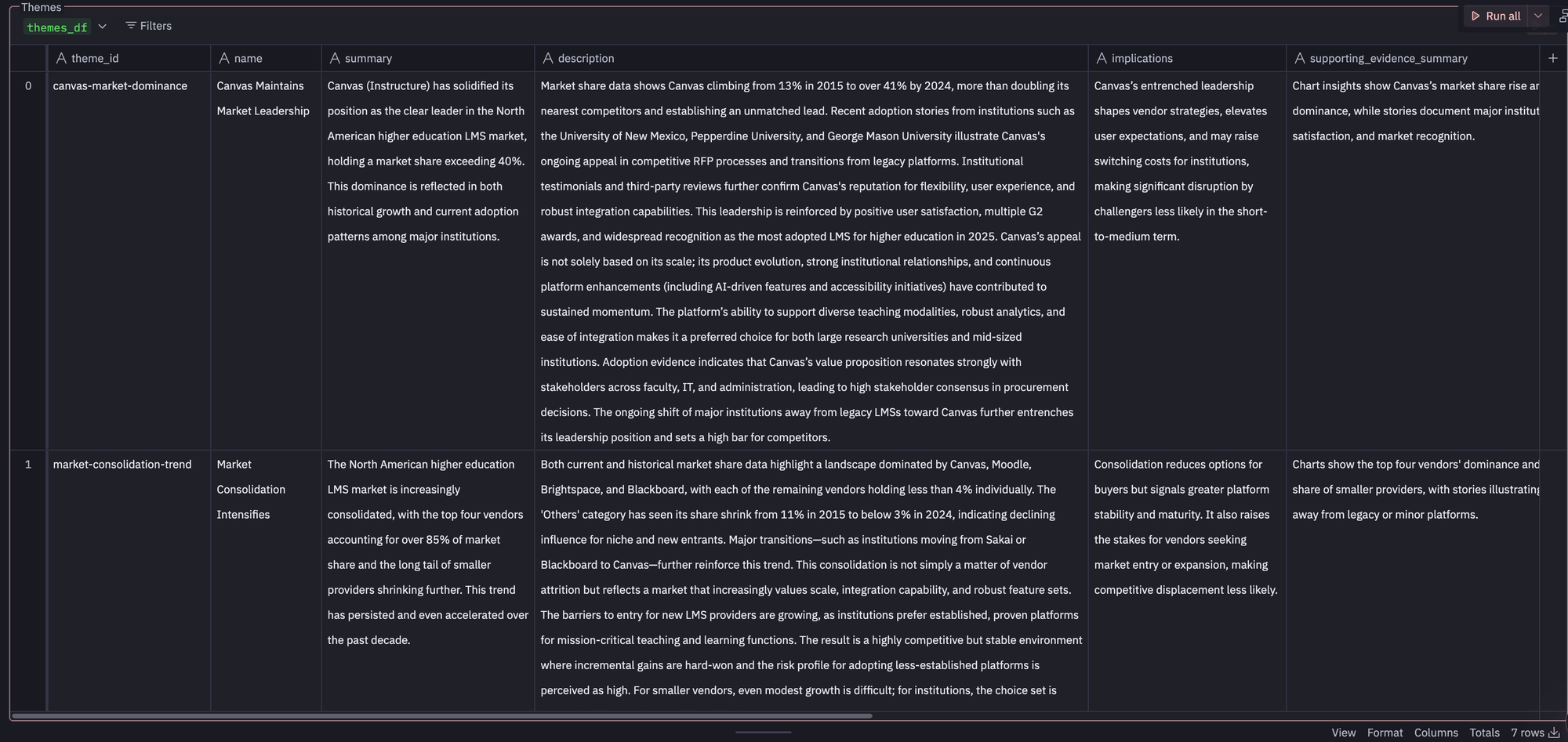
Business Impact and Technical ROI
The pilot multi-agent intelligence system demonstrated significant potential for competitive advantages through automation, cost efficiency, and consistency compared to traditional research methods.
ROI Analysis: Pilot Results vs. Traditional Research
Demonstrated Advantages:
- Cost Efficiency: $400/month operational cost vs. $4,000/month analyst equivalent (0.5 FTE)
- Automation Success: Estimated 50% reduction in manual validation workload (client feedback)
- Technical Feasibility: Proved multi-agent AI can generate market intelligence reports
- Methodology Consistency: Reproducible approach vs. analyst variability
- Scalability: Configuration-driven architecture enables expansion to new verticals
Pilot Implementation Results
- Theme Generation: Successfully demonstrated automated synthesis of internal and external data
- Evidence Chains: Built audit trails linking chart insights to external sources
- Strategic Context: Generated business implications from combined data sources
- Executive Format: Automated assembly of executive-ready intelligence reports
Data Fusion Value Demonstrated
- Context Amplification: Internal data gained strategic meaning through external context
- Validation Chains: External sources validated internal market position data
- Predictive Potential: Combined data revealed market direction indicators
- Executive Accessibility: Complex data transformed into actionable strategic intelligence
Building Your Intelligence Advantage
The ListEdTech pilot demonstrates that AI-powered market intelligence is not theoretical—it's a proven technical capability that can deliver significant operational advantages. The question for organizations is whether to build this capability internally or partner with experts who've already solved these challenges.
Strategic Decision Framework
Choose Expert Partnership When:
- Time-to-market pressure requires results in 6-8 weeks
- Limited AI/LLM engineering experience on your team
- Need to prove business case before major engineering investment
- Require specialized domain expertise in market research and competitive intelligence
Build Internally When:
- AI capability development is a strategic priority for your organization
- Have experienced LLM engineering team with 6+ months production experience
- Long-term competitive advantage requires proprietary intellectual property
- Regulatory or security requirements mandate internal development and control
Getting Started
Immediate Actions:
- Strategic Assessment: Evaluate build vs. partner decision using framework above
- Use Case Identification: Select high-value pilot opportunity for intelligence system
- Capability Review: Assess current AI/LLM engineering team capabilities
- ROI Modeling: Project potential impact using demonstrated pilot metrics
Next Steps:
- Strategy Consultation: 30-minute assessment of your intelligence needs and implementation options
- Technical Architecture Review: Evaluation of your existing data infrastructure and integration requirements
- Pilot Program: 6-week proof-of-concept with your real business data and measurable outcomes
Whether you build or partner, the competitive advantage of data fusion is clear: organizations that connect their internal intelligence with external signals will outpace those operating with incomplete information.
Ready to explore AI-powered intelligence for your organization?
Contact us for a 30-minute strategy consultation to assess your data
fusion opportunities and implementation options.


